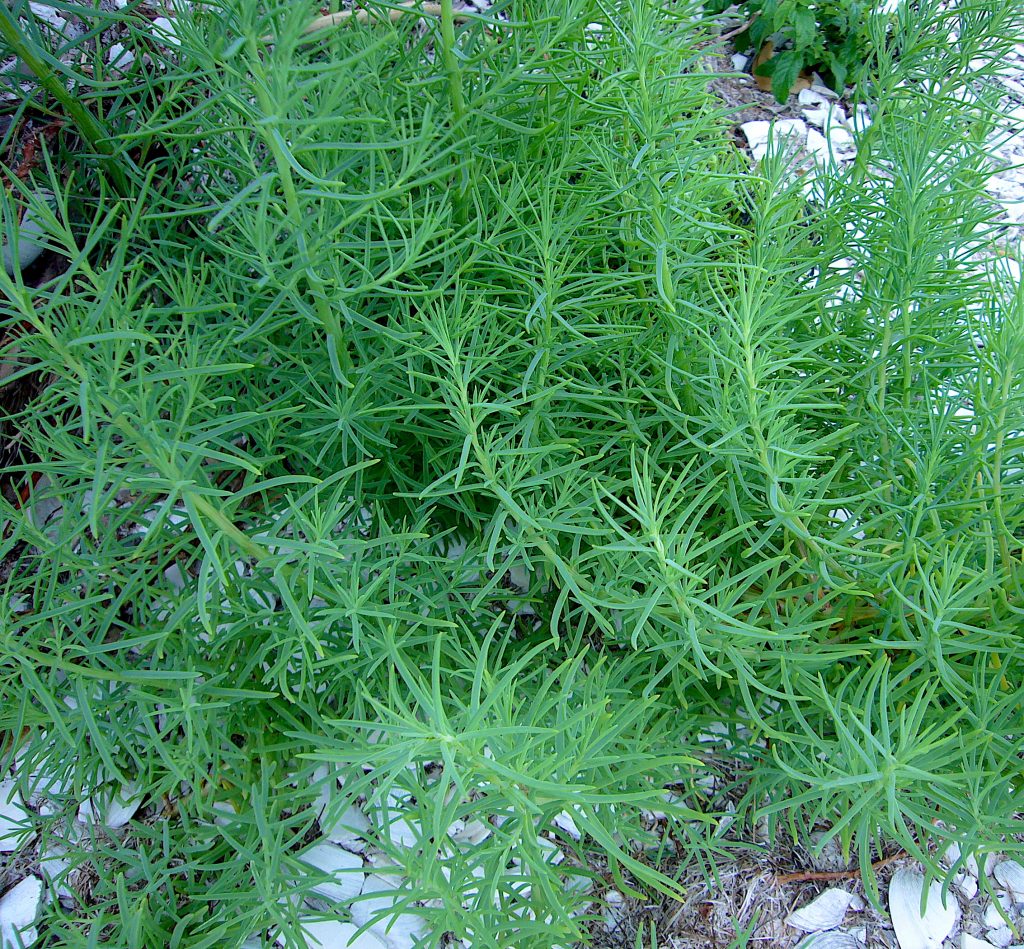
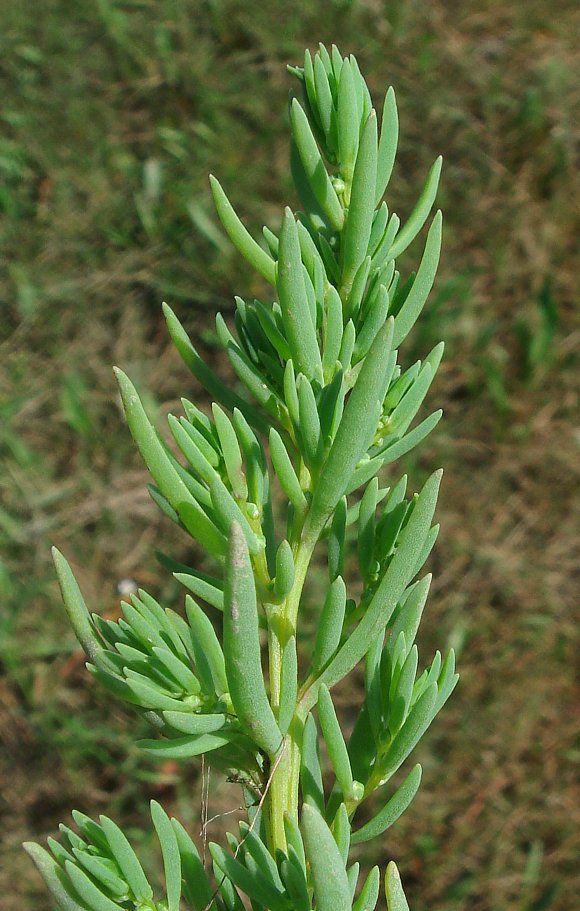
There’s still time to look for Sea Blite, a seasonal salt-tolerant species that’s here this month, gone next month. The season is a little longer than that but not long enough. We saw some this week while at Emerson Point Preserve in Palmetto, Fl. A member of the Chenopodium group it’s my candidate for a commercial crop. I often get governmental requests for Glasswort seeds but never Sea Blite whereas the latter is a great food. Edible raw or cooked, it has a mild flavor and pleasant texture. Sea Blite is salty from growing near brackish water but it will easily grow in your non-salty garden as well. The only drawback I can tell — besides its name — is that it’s a seasonal crop. But so, too, is most of the food found in our produce sections. I think it would be a very successful commercial crop. You can read about it here.
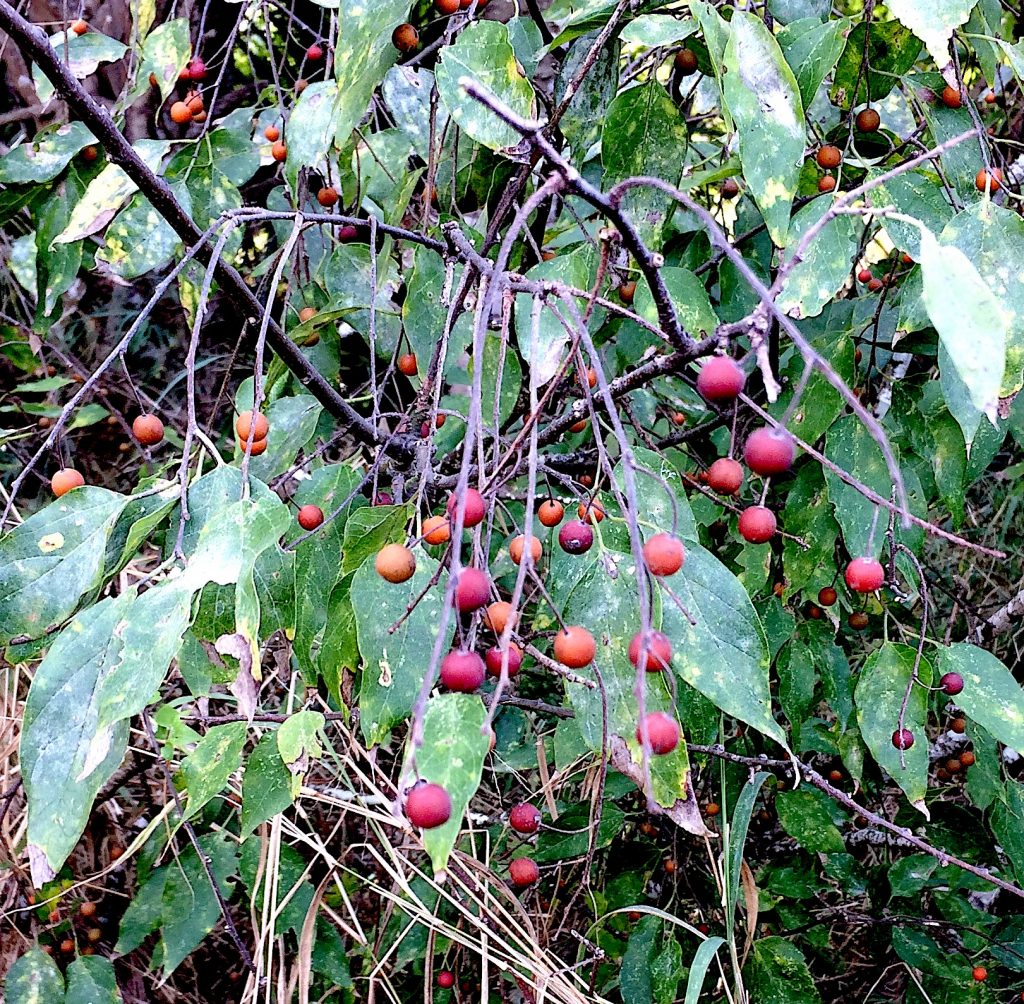
People launch into arguments over the common names of plants. That should not come as a surprise: Botanists get into arguments over the official names of plants. So is this tree a “Sugarberry” or a “Hackberry?” Some will argue the distinction is geographic, other will assert the names apply to different species. I call it a big tree with little burnt-orange fruit that is edible around now. I’m writing about them now as they are setting fruit which resemble green peas. They ripen around September.
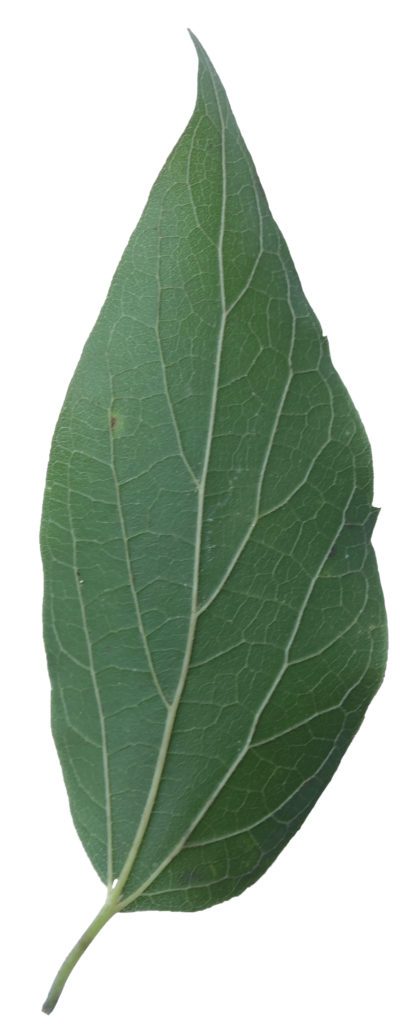
A couple of good identifying characteristics of the Sugarberry are the uneven leaf shoulders near the stem and three main veins at the base of the leaf. Also in real estate it is “location, location, location.” It’s similar in foraging: Knowing where to look and what you’re looking for. Hackberries-Sugarberries like to be near fresh water such as lakes, ponds, streams or a very reliable irrigation-sprinkler system. They don’t like being waterlogged. But, you won’t find them on the top of a dry hill either. Usually you can find them up the bank from water. Older trees usually have warty bark, no thorns. Often the leaves have many insect galls and or a black smut on them (the latter does not affect the tree or us. It is also found on useable persimmon leaves.) The pea-sized fruit is burnt to medium orange in color sometimes red depending on the species. The entire fruit is edible though the seed is hard. So you can eat the pulp, and or crunch the seed, or mash entire fruits into cakes. To read more about the Hackberry or Sugarberry go here.
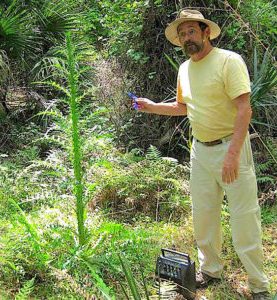
My foraging classes this weekend are both mid-state, one near Deland and one south of Ft. Mead. Like the coasts the center of the Florida peninsula has area specific species.
Saturday, May 4th, Colby-Alderman Park: 1099 Massachusetts Street, Cassadaga. Fla. 32706. 9 a.m. to noon. Meet by the bathrooms.
Sunday, May 5th: Ft. Meade Outdoor Recreation Area, 1639 Frostproof Highway, Fort Meade, FL 33841. (Frostproof Highway is also Route 98.) 9 a.m to noon. Meet at the brown bathrooms in the middle of the park which is due south from the highway.
Saturday, May 11th, Dreher Park, 1200 Southern Blvd., West Palm Beach, 33405. 9 a.m to noon. Meet just north of the science center in the north section of the park.
Sunday, May 12th, Lake Woodruff National Wildlife Refuge, 2045 Mud Lake Road, DeLeon Springs, FL. 9 a.m. to noon. A few hundred feet after crossing the railroad tracks on Mudlake Road there in the parking lot on your right. We meet there. This is a hike of approximately four miles, two out and back mostly native species, very few ornamentals. While the walking is easy we are exposed to the elements, sun on a clear day, wind on a cold day. Check the weather, dress appropriately. Bring water, wear suitable footwear. Know that as it is federal land it can be closed anytime for any reason without notice.
Saturday, May 18th, Florida State College, south campus, 11901 Beach Blvd., Jacksonville, 32246. 9 a.m. to noon. We will meet at building “D” next to the administration parking lot.
Sunday, May 19th, Boulware Springs Park, 3420 SE 15th St., Gainesville, FL 32641. 9 a.m. to noon. Meet at the picnic tables next to the pump house.
Saturday, May 25th, Blanchard Park, 10501 Jay Blanchard Trail, Orlando, FL 32817. 9 a.m. to noon. Meet next to the tennis courts by the YMCA building.
Sunday, May 26th, Eagle Park Lake, 1800 Keene Road, Largo, FL 33771. 9 a.m. to noon. Meet at the pavilion near the dog park.
Saturday, June 1st, Bayshore Live Oak Park, Bayshore Drive. Port Charlotte. 9 a.m. to noon. Meet at the parking lot at the intersection of Bayshore Road and Ganyard Street. 9 a.m. to noon.
Sunday, June 2nd, Wickham Park: 2500 Parkway Drive, Melbourne, FL 32935-2335. 9 a.m. to noon.Meet at the “dog park” inside the park.
Saturday June 8th, Wekiva State Park, 1800 Wekiwa Circle, Apopka, Florida 32712. 9 a.m. to noon. Arrive early as there will be a lot of people wanting to go to the springs to swim. There is a park admission Fee: $6 per vehicle. Limit 8 people per vehicle, $4 for a single occupant vehicle, $2 pedestrians or bicyclists. Meet at the Sand Lake parking lot (road on left after entrance. Go to end of road.) Unlike city parks or the urban area, Wekiva Park is “wild” Florida. There are very few weeds of urbanization. The edibles are mostly native plants and far between. There is a lot of walking in this class.
Sunday, June 9th, Red Bug Slough Beneva Road, Sarasota, FL, 34233. 9 a.m. to noon. Meet at the parking lot.
For more information about the classes or to sign up go here.
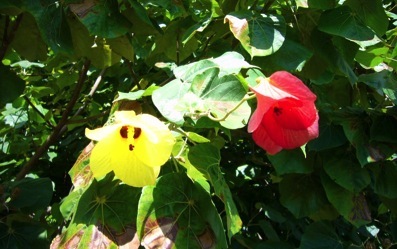
Foraging is treasure hunting for adults. While waiting for a bike to be assembled in Orlando I took a walk around the neighborhood of College Park. It had the usual species one would expect to find in this part of Florida this time of year except for a Variegated Mahoe. This is a south Florida landscape tree. There is one where my classes are held in West Palm Beach, 189 miles to the south. Related to the hibiscus the young leaves, inner bark, tender roots, and blossoms are edible. In fact the blossoms start the day yellow and turn red in the afternoon to attract different pollinators. I can only guess what one was doing alive in the Orlando area. As it was a foot through at the base perhaps it was planted way back in the last century when the winter temperatures were warmer. You can read about the Mahoe here.
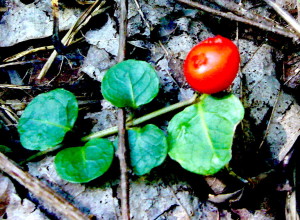
Speaking of finding treasure… In the Carolinas in August I see a lot of Partridgeberries, also called Twin Berries because the separate blossoms fuse into one berry. They are edible and mild yet they are attractive with striking red berries and deep green leaves. Partridgeberries are not extroverted but if you see them they are attractive. One spring a sharp-eyed lad saw them during a class I had in Gainesville. That was the first time I had ever seen them in Florida. Unfortunately that location was flooded by Hurricane Irma in 2017 and has not dried not since. I’ve also seen them in Wekiva State Park. According to the USDA chart it is not in Seminole County whereas the park is. Seasonally Florida and North Carolina are — as far as the Partridgeberries are concerned — about five months apart. As with the Carolinas these were spotted in damp but not inundated soil. You can read more about Partridgeberries here.
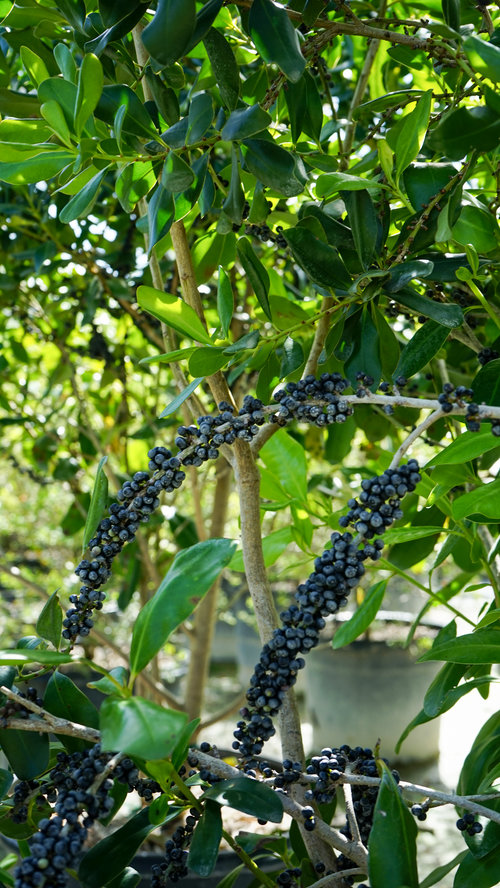
Let’s revisit Marlberries. They are fruiting now and edible. As I’ve written I don’t see then too often, a few times of year mid-state or south. They were in profusion this past week at Emerson Point in Palmetto. In some spots they seemed to be the dominant understory species. They are not a great trailside nibble and complicating things is that they vary substantially in quality. Marlberries are also related to the invasive species Coral Berry, Ardisia crenata, which has been implicated in cattle poisoning. In the same habitat, though fruiting all year, you can see Rapanea punctata, Colicwood, one of those mystery pants one finds in wet but not salty woods. Also called Myrsine guianensis, Myrsine cubana and Rapanea guianensis Colicwood’s small yellow blossoms and black fruit grow directly on the branches, helping you identify it. There’s not a lot of literature on the species so the berries are probably not edible. Indeed, Professor Julia Morton, who was a wild food advocate and forager in south Florida and known to eat nearly everything possible, said only the birds eat the shiny black berries. As it is called “Colicwood” that does suggests some medicinal uses. Another name for the species is “Rat Feces” and leaves were used by the Miccosukee Indians to extend their tobacco. Colicwood is reported as far north as Daytona Beach but I have only seen it at Emerson Point. To read more about the Marlberry and its strange relatives go here

All My Videos are available for free on You Tube. They do have ads on them so every time you watch a Green Deane video I get a quarter of one cent. Four views, one cent. Not exactly a large money-maker but it helps pays for this newsletter. If you want to see the videos without ads and some in slightly better quality you can order the DVD set. It is nine DVDs with 15 videos on each for a total of 135 videos. Many people want their own copy of the videos or they have a slow service and its easier to order then to watch them on-line. The DVDs make a good gift for that forager you know especially as spring is … springing. Individual DVDs can also be ordered or you can pick and choose. You can order them by clicking on the button on the top right hand side of this page (if your window is open wide enough.) Or you can go here.

Donations to upgrade EatTheWeeds.com have gone well. Thank you to all who have contributed to either via the Go Fund Me link, the PayPal donation link or by writing to Green Deane POB 941793 Maitland FL, 32794.

Want to identify a plant? Looking for a foraging reference? Do you have a UFO, an Unidentified Flowering Object you want identified? On the Green Deane Forum we chat about foraging all year. And it’s not just about warm-weather plants or just North American flora. Many nations around the world share common weeds so there’s a lot to talk about. There’s also more than weeds. The reference section has information for foraging around the world. There are also articles on food preservation, and forgotten skills from making bows to fermenting food. One special section is “From the Frightening Mail Bag” where we learn from people who eat first then ask questions later. You can join the forum by clicking on “forum” in the menu.
This is weekly issue 353.

